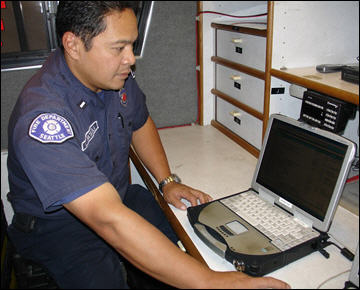|
People Using CAMEO
Over the past two decades, CAMEO has become the most widely used chemical emergency response and planning tool in the United States. CAMEO users include:
- First responders (such as fire and police services);
- State, local, and industry planners; and
- Environmental organizations and academics.
 |
A member of Seattle Fire Department hazardous materials response
team works with CAMEO in the hazmat vehicle.
|
Most people use the CAMEO programs to respond to or plan for accidental chemical releases. However, some users have gone beyond the basic uses, for example:
- Aerial ambulance companies have used MARPLOT to provide the direction and distance to local hospitals to help expedite patient transport.
- CAMEO, ALOHA, and MARPLOT are all used by first responders at the Weapons of Mass Destruction training developed by the Department of Homeland Security.
- After entering chemical inventories and special locations into CAMEO, some planners are assessing likely terrorist targets within their area using CAMEO and LandView.
Hurricanes Katrina and Rita
After Hurricanes Katrina and Rita, emergency responders used CAMEO to complete challenging response tasks such as:- Estimating the number of affected residences in New Orleans,
- Mapping evacuation routes and collection sites for hazmat containers displaced by the storm,
- Defining exclusion zones around dangerous hazmat containers, and
- Selecting safety gear for workers handling hazardous debris.
|  |  | | The hurricanes scattered hazardous debris across several states. LEFT: containers lay in a jumbled pile after Katrina passed through a New Orleans rail yard. RIGHT: a large tank was left behind in a yard when Rita's storm surges receded. |
United Nations Environment Programme (UNEP)
UNEP selected CAMEO as a tool to help developing nations prepare for and respond to chemical accidents. Under UNEP's Awareness and Preparedness for Emergencies at the Local Level (APELL) program, CAMEO has been demonstrated or taught in 50 countries and has been translated into French and Spanish. To find out more about UNEP, select the link titled United Nations Environment Programme at right.
|


